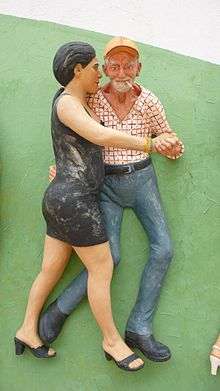Rigoberto Torres
Rigoberto Torres (born 1960) is a sculptor who was born in Aguadilla, Puerto Rico and worked in New York City, before moving to Florida where he currently lives and works.[1] Torres began working in a factory where religious figures were cast,[2] producing religious statuary.[3] He also considers himself to be a community based artist.[4]
Rigoberto Torres | |
|---|---|
| Born | 1960 |
Sculptures

Torres is known in part for the sculptures in plaster and fiberglass that he created of his neighbors in the Bronx, together with his partner John Ahearn. Between the years 1981 and 1985, they collaborated on four murals. These were We Are Family, Life on Dawson Street, Double Dutch, and Back to School.[5] The sculptures, like much of Torres' work, were displayed in public attached to buildings, free standing and in street events as an element of performance art.[1] On many occasions, Torres would prompt Ahearn to move their studio to the sidewalk along Walton Avenue so that neighborhood children could watch and also volunteer as subjects.[6][7]
Torres' sculptures show an instinctive drive to create tableaux[8] from single figures and are included in the field of humanistic naturalism because they accurately portray people.[1] He met frequent collaborator Ahearn in 1980, when Torres was working in a factory casting religious statues. They worked together on the Bronx sculptures, sometimes known as the South Bronx Hall of Fame, creating monuments to ordinary people as a response to the practice of enshrining famous, heroic figures in public places.[9]
Biography
Torres was born in Aguadilla, Puerto Rico, in 1960. At age four, he moved to New York, first in upper Manhattan and then to the Bronx.[10]
In 1990 he returned to Puerto Rico where he produced twenty-two works over the course of a year, including Ruth Fernandez in 1991.[10]
Notes
- Kristin Congdon; Kara Kelley Hallmark (2002). Artists from Latin American cultures. Greenwood Publishing Group. ISBN 0-313-31544-2.
- Adrichem, page 120
- Art in review (accessed April 27, 2009)
- Boughton, Mason, page 74
- Kwon, page 89
- Woodward, page 106
- Hoffman, 223
- Grace Under Pressureby Dan Cameron (accessed April 27, 2009)
- Jan van Adrichem; Jelle Bouwhuis; Mariette Dölle (2002). Sculpture in Rotterdam. 010 Publishers. ISBN 90-6450-482-2.
- Cameron, Dan. "The Works of Rigoberto Torres: Introduction". www.lehman.cuny.edu. Retrieved 2009-04-27.
References
- Woodward, Gary C. (2003). The idea of identification. SUNY Press. ISBN 0-7914-5819-9.
- Kwon, Miwon (2004). One Place After Another. MIT Press. ISBN 0-262-61202-X.
- Adrichem, Jan van; Jelle Bouwhuis; Mariette Dölle (2002). Sculpture in Rotterdam. 010 Publishers. ISBN 90-6450-482-2.
- Hoffman, Katherine (1997). Westview Press. ISBN 0-06-430211-3. Missing or empty
|title=(help) - Boughton, Doug; Rachel Mason (1999). Beyond multicultural art education. Waxmann Verlag. ISBN 3-89325-783-7.